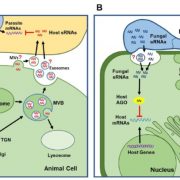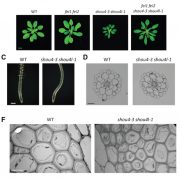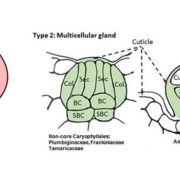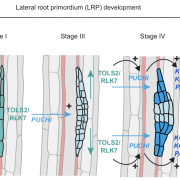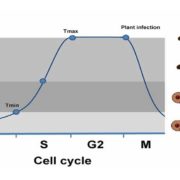How Meiotic Chromosomes Cluster into a “Bouquet”
Zhang et al. explore the behavior of chromosomes during meiosis. The Plant Cell (2017). https://doi.org/10.1105/tpc.17.00287
By Fanfan Zhang
Background: In meiosis, plants, animals, and fungi reduce their chromosome numbers by half to form gametes (sperm and eggs) that can fuse to form a cell with a complete set of genetic material. During one stage of meiosis, chromosomes huddle together and the chromosome ends (telomeres) cluster in a limited area of the inner nuclear membrane. This cluster of chromosomes looks like an attractively arranged bunch of flowers, so it is widely called the “chromosomal bouquet”. Chromosomal bouquet formation happens in nearly all plants, animals and fungi, and plays an important role in pairing of the chromosomes and therefore progression of meiosis.
Question: In recent years, work in yeast and mammals has identified some essential factors participating in bouquet formation, but they are not conserved across species. So far, the underlying molecular mechanism in plant species remains largely unknown. So, we wanted to know what leads to the aggregation of chromosomes during meiosis in plants.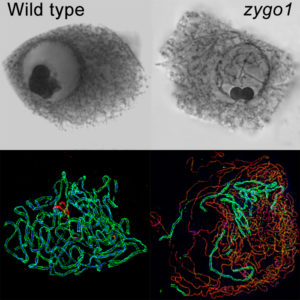
Findings: Based on a genetic screen for sterile mutants in rice (Oryza sativa), we identified ZYGOTENE 1 (ZYGO1), a novel protein that regulates bouquet formation during early meiosis. The zygo1 mutants fail to form proper bouquets and the mutant rice therefore lack typical meiotic cells at this stage. Because the plants cannot form proper gametes, they are sterile. Staining of the proteins on chromosomes in meiosis showed that the polarized localization of a protein that promotes telomere movement is also altered in the zygo1 mutants. All of these results suggest that ZYGO1 plays an essential role during telomere bouquet formation. We also found that ZYGO1 affects chromosome behavior independently of double-strand break formation and recombination. In addition, the failure chromosome clustering in the zygo1 mutants further affects other aspects of chromosome behavior, including homolog pairing, synaptonemal complex assembly, and crossover formation. ZYGO1 encodes an F-box protein, containing an F-box domain with some conserved residues. Our results showed that ZYGO1 interacts with the rice SKP1-like protein 1 (OSK1) through its F-box domain, suggesting that ZYGO1 modulates bouquet formation as a component of cellular factors involved in breaking down proteins.
Next steps: This investigation lays an important foundation for uncovering the molecular mechanism underlying chromosome clustering during meiosis. Further research towards identification of the target(s) of ZYGO1 will shed light on its specific function.
Fanfan Zhang, Ding Tang, Yi Shen, Zhihui Xue, Wenqing Shi, Lijun Ren, Guijie Du, Yafei Li, and Zhukuan Cheng (2017) The F-box protein ZYGO1 mediates bouquet formation to promote homologous pairing, synapsis, and recombination in rice meiosis. tpc.00287.2017; https://doi.org/10.1105/tpc.17.00287



